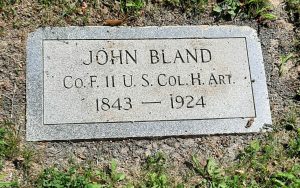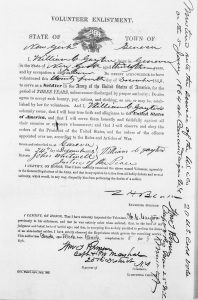African American Veterans Buried At Glenwood Cemetery
By Becky Chapin, Archivist
In 2021, part of my Glenwood Cemetery tour was focused on African American veterans in the Swift Post Veteran’s Plot (formerly Soldier’s Hill). Here are some of their stories, shortened for the purposes of this blog.
John Bland was born in 1843 and died on January 24, 1924. John enlisted in the 11th US Colored Heavy Artillery on December 5, 1863 and served during the Civil War.
His father, George Bland, was one of very few Black Genevans highlighted in the 1876 publication History of Ontario County. George was born in Geneva in 1818 and is likely a descendant of one of the Bland men who were enslaved by John Nicholas and brought to Geneva in 1803.
John Bland’s grandfather and uncle were the largest African American property owners in Geneva in the early 19th century, buying lots in the 1820s on Liberia Street. In 1845, a group in that neighborhood petitioned the village to change the name to Bland Street in honor of the first John Bland who was seen as a positive symbol of progress. The village declined to change it, instead renaming the street in 1856 to West Street.
George Bland was educated in the schools in Geneva and became a kalsominer, or white washer. He is buried in Washington Street Cemetery. John began work as a day laborer in his teens, but after serving in the military he followed in his father’s footsteps. John was highly sought after according to an 1874 article from the Waterloo Register that is quoted in the Geneva Daily Gazette. “John is a fine artist as his work shows, but he has so much business to attend to in Geneva that he cannot find much time to ornament Waterloo.”
John’s obituary reveals that he was a prominent amateur oarsman and was part of the Geneva Rowing Association. By 1879, his whitewashing business was so profitable that he was able to invest in a restaurant and catering business with Will Gillam, who was a fellow amateur oarsman.
I’ve previously published a blog about Benjamin Cleggett. His business partner Theodore Duffin is also buried in the veteran’s plot. Though his stone is lost, city records indicate he is buried in row 7. Theodore enlisted on July 29, 1863 in Wayne County for the 8th US Colored Troops.
His parents were James and Charlotte Duffin, and he had three brothers and two sisters. James was involved in suffrage meetings and attended several colored people’s conventions while Charlotte represented Geneva as one of four Black women on a committee formed to raise funds in support of Ward’s Impartial Citizen at the 1849 Auburn emancipation celebration and the New York State Fair that year.
William C. Gayton was born around 1830 or 1831 and died September 15, 1876. He enlisted as a private in Company D, 26th Regiment of the US Colored Troops on December 24, 1863 along with three other family members (Aaron, Samuel, and George) through January 1865, and all Gaytons lived to return home. William was sent to South Carolina, appointed corporal in February 1864, rising to the rank of sergeant in November 1864. It’s likely that he participated in the Battle of Bloody Bridge and Honey Hill as well as other battles.
When he was mustered out, William paid six dollars to keep his rifle and other equipment. He was originally buried in the potter’s field of Washington St. Cemetery but in 1909, the Swift Post GAR No. 94 applied for the removal of the remains of various deceased soldiers who were buried in the potter’s fields of both Washington St. and Glenwood Cemeteries to be reinterred in Soldier’s Hill.
Also moved with William was Harvey Burns, who also enlisted in Company D, 26th regiment of the US Colored Troops. Both William and Harvey had unmarked graves in 1879 when Congress set forth an act to identify the graves of union soldiers, as did another Black man who is buried in Soldier’s Hill, Walter Johnson, though his stone is missing.
Harvey Burns had a tragic ending to his life when in August 1870 he drowned in Seneca Lake. Since Harvey was single, his remains were given to the Swift Post GAR to intern. Harvey was described as “a quiet, orderly person enjoying the good opinion of those of both races to whom he was acquainted. Late in the war he joined the army, serving in the 26th regiment of US Colored Troops Company D till hostilities ceased, and proved as good a soldier as any of his race.”
Walter Johnson enlisted on December 5, 1863 to Company K, 11th US Colored Heavy Artillery. His military papers show he was 19 years old at the time, estimating his birth date around 1843 or 1844. He mustered out on October 2, 1865. He was a native Genevan, born to Edward and Catharine Johnson and had several siblings. Edward was listed as both a cartman and barman in the census. Walter was a retired porter at the time of his death and was boarding with Joseph and Mary Gillam.
Joseph Gillam was born in 1845 and died June 24, 1930. He enlisted December 17, 1864 at the age of 15 to Company D, 20th regiment US Colored Troops using the alias Joseph Williams. He left his parents Joseph and Harriet Gillam, two sisters Adalaide and Mary, and his brother Philip.
Joseph’s cousin Charles Derby wrote in support of Joseph’s application for a pension many years later to explain that the reason for the alias was that Joseph feared his father would find him and force him to return home.
After Joseph mustered out, he worked as a deliveryman at age 17 before becoming a barber on Seneca Street, moving his shop over to High Street near his home by 1925. He was one of the last African American barbers in Geneva by 1915.
Joseph married Mary Douglass, the daughter of former slaves Henry and Louisa Douglass who were enslaved and brought to Geneva by the Rose family. Mary herself is buried in section 18. Joseph served as a color guard for the Swift Post for a number of years.
Joseph and Mary were involved in many activities of the High Street Chapel, and Joseph was elected as the first president for their first Sunday School class. Joseph was also involved with the Emancipation Celebrations along with Benjamin Cleggett, often acting as a marshal.
Our final veteran is James Linzy, who was born February 24, 1886 and died March 17, 1959. James’ parents were Minor and Dolly Linzy, both born into slavery in Virginia. They had nine children together, Laura, Mabel, Daniel, Stanley, James, Minor Jr., Irma, Viola and Cora. In 1903, they rented a two-acre farm on the western outskirts of Geneva and were able to buy it in 1919.
James served in World War I after he was recruited in Rochester, NY as a private on November 22, 1917. He served in Battery E, 349th Field Artillery until he transferred to the supply company in March 22, 1918, then was appointed to the NY Wagoner April 1, 1918. He was in the Marbache Sector from October 16, 1918 through November 9, 1918, and remained in France until January 1919, honorably discharged at Long Island on July 18, 1919. He returned to his wife Viola May Jarvis in Geneva whom he had married in August 1908.



Wow. What a write up. There certainly a ton of history. Thank you.
Becky, Thanks for all this information. Great research! Nice to learn about people that are part of Geneva’s African American history.
I visited Soldier Hill this morning. Some one has done a magnificent job,. cleaning and storing the area. Thanks to who ever worked on the project
You can thank Hank Roenke and Mike Hanna. They have done the excellent work there.
Congratulations on yet another extraordinary post with a wealth of unknown history that makes Historic Geneva one of the finest historical societies in America. I hope that you will offer a proposal that West Street be named Bland Street. If I lived in the community I would certainly support such a worthy undertaking.